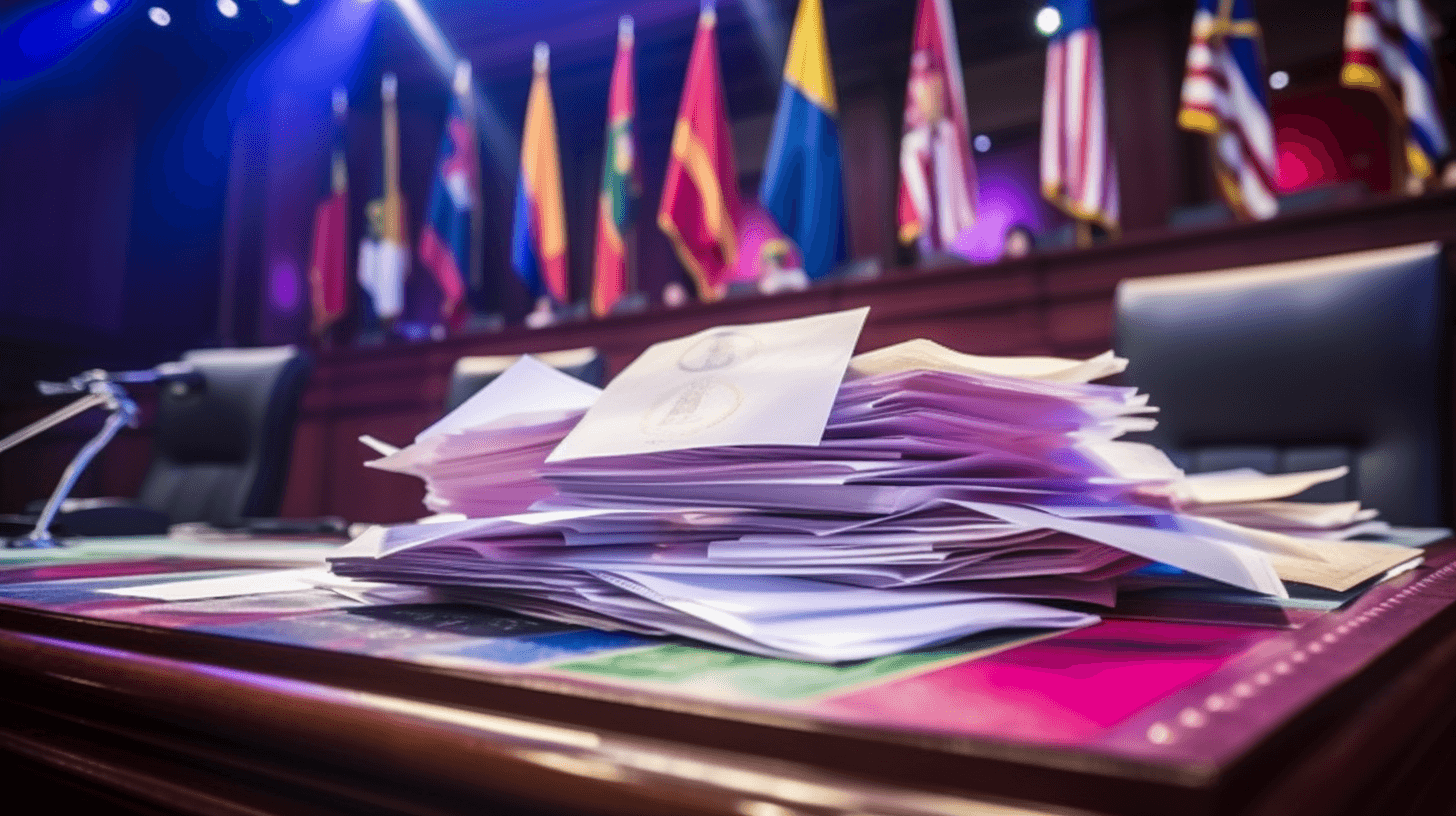🎓💸💼 Da Time Fo Payin Student Loans Stay Coming Back. Dis How Fo Get Ready
📚🤔💸 One deal fo raise da debt ceiling goin make borrowers of federal student loans start payin again afta pauing since da pandemic start early.
📅🔛 Afta one three-year break, student loan payments goin start again.
🛑📜 Da pau button on federal loans stay extended eight times since March 2020 as one relief fo da pandemic.
🤝 Dis time, howeva, da big restart stay part of da law: As one agreement between President Biden an Speaker Kevin McCarthy fo raise da debt ceiling, da pau button goin be released “60 days afta June 30,” around September 1. Not too different from da timeline dat Mr. Biden wen lay out before, but by puttin um in da law, he might get less room fo extend da pau yet again.
💼👨💼 Da pau break wen help bout 27 million borrowers an anodda seven million who wen default by stop dem from garnishin wages an doin odda collection ting. Interest neva pile up too.
💰🔍 Your money situation might look diffren from three years ago, so borrowers gotta take one moment fo see wea dey stay — hopefully long before loan servicers stay overwhelmed wit phone calls an questions. Hea everyting you gotta know.
❓🏷️ Wat da first ting I gotta do? Make sure your student loan servicer can find you. Go on your servicer’s website an check if dey get yo current contact details: email address, mailin address, an phone numbah.
🔎😕 No know who your servicer stay? Go on StudentAid.gov, find yo account dashboard, an scroll down to da “My Loan Servicers” part. You can also call da Federal Student Aid Information Center at 1-800-433-3243.
🗓️🔄 Wen my payments goin restart? An how?
You goin get one notice or bill statement at least three weeks before yo first payment stay due. Dat goin have da amount you gotta pay an wen you gotta pay um. If you no like wait, you can contact yo servicer fo get dat info now.
💻🔐 Dis stay importan: If you was on one automatic payment plan befoe da pandemic — befoe March 13, 2020 — you gotta opt back in. Yo servicer goin reach out to you bout dis. If you no respond, yo payments no goin start again automatically.
💲💥 If you wen sign up fo autopay afta dat date, automatic payments goin restart. Borrowers who neva stop making payments no need do nottin at all. If you miss da first payment, no need panic. Just contact yo servicer an make arrangements fo catch up.
❓💡 How any potential loan cancellation goin work?
Plenny borrowers goin see up to $20,000 of their balance vanish if da Supreme Court let da Biden administration move forward wit dey plan fo cancel debt. (One decision suppose come out by end of June.) Da program goin cancel $10,000 of debt fo single people making unda $125,000 an married couples an heads of households making unda $250,000. Borrowers who wen get Pell Grants an fall unda da income limits can qualify fo anodda $10,000 in debt relief. Debt cancellation goin happen automatically fo borrowers who wen already apply an get approved, an fo dose who no need apply cuz da government already get dey info on file, da people who support borrowers say. Dose who apply but neva get approval no need do um again. Payments goin get recalculated based on yo new balance. Payments fo borrowers already on income-driven plans, howeva, no goin change even if part of dey debt stay canceled. Dass cuz dey payments stay based on dey discretionary income an how big dey household stay.
💸❓ I no can afford my loan payment. Wat I goin do?
Good ting is dat federal borrowers get plenny options. But having so much choices can make tings hard, especially wen each one get diffren rules an outcomes. But dey get three general categories:
📏 Fixed payment plans: Dese include standard (fixed payments), graduated (yo payments go up), an extended (you pay for long time) repayment plans.
💰💡 Income-driven repayment plans: Dis plans base payments on yo income an how big yo family stay, an you might end up paying as low as $0 every month. Afta couple decades of payments, da government goin forgive any remaining balance you still get. Dis goin probably be da best choice fo plenny borrowers who struggle fo make payments.
⛔💼 Last resorts: Borrowers can also ask fo deferment or forbearance, wea dey pau payments temporar’ly — even dough dey can have big costs in da long run. Wit forbearance, you no need make payments but da interest still stack up. If you no pay da interest, dey add um to the principal balance of da loan. Deferment stay similar, but subsidized loans — which usually get bettah terms — no accrue interest while dey on hold.
❓🔍 Tell me moa bout income-driven plans.
Da rules stay complicated, but da main idea stay simple: Payments base on how much you make an how big yo family stay, an dey adjust every year. Afta you make monthly payments fo certain number of years — usually 20, sometimes 25 — any remaining balance goin get forgiven. (You gotta pay tax on da forgiven balance, but right now dey get one temporary tax rule dat make balances forgiven through 2025 no count fo federal income taxes.)
💡🔢 Right now, get plenny plans fo choose from. You get PAYE (Pay as You Earn), REPAYE (Revised Pay as You Earn), I.C.R. (Income-Contingent Repayment), an two versions of I.B.R. (Income-Based Repayment). One moa — more affordable — plan stay in development, but we go explain dat latah.
💲📐 Monthly payments usually be 10 or 15 percent of yo discretionary income, but one plan be 20 percent. Unda da current plans, discretionary income usually mean da amount you make above 150 percent of da poverty level, an dat amount change based on how big yo household stay.
💼📚 Da calculations no account fo local cost of living, private student loans, medical bills, an odda tings. But fo plenny borrowers, dey still one bettah solution.
🏢💼 Da Biden administration wen propose one less expensive income-driven plan. Wat da status?
Da plan dey propose would change da existing income-driven plan known as REPAYE, an could cut payments fo millions of borrowers by moa than half.
📜📅 Da Education Department wen release da proposal in January, an one final rule — wea dey might make some changes from da original proposal — wen go to da White House fo review on May 23.
“Dem could approve um pretty quick,” said Abby Shafroth, one director of da Student Loan Borrower Assistance Project at da National Consumer Law Center, “or dey could find problems an send um back to da Department of Education fo change.” Even afta da final plan stay approved an published, goin take time fo set um up, so hard fo say wen you can enroll.
💰🔄 How da new plan goin work?
Da proposed plan goin be bettah in few ways. Fo start, it goin lower payments on undergraduate loans to 5 percent of discretionary income, down from 10 percent unda da current REPAYE plan.
🎓💸 Graduate debt also qualify, but borrowers goin pay 10 percent of dey discretionary income fo dat part. If you get both undergraduate an graduate debt, yo payment goin depend on how much you owe fo each.
🔢💼 Da proposed plan also change da formula fo payments, so you get moa money protected fo yo basic needs. Dass goin make overall payments lower. Dis change also goin let moa low-income workers qualify fo $0 payments.
🔐📜 But some borrowers no goin get access: Da new plan no open fo parents who borrow money fo dey kids’ education using Parent PLUS loans. Dey only qualify fo one income-driven plan, I.C.R.
⌛🔄 Wen da revised REPAYE plan come out, da Biden administration also propose to make da I.D.R. landscape simpler an limit new enrollment into certain plans. But borrowers wit Parent PLUS loans no goin lose access to da I.C.R. plan. Dey still can enroll in dat plan afta consolidating into one direct consolidation loan.
❓💡 How I choose da best plan?
You can use the loan simulator tool on StudentAid.gov fo help. It goin guide you through the options an help you decide which plan work best fo you.
💻✨ An it easy fo use. Wen you sign in, da tool goin use yo loans fo da calculations. (You can add odda federal loans if dey missing.) You can also compare plans side by side — how much dey goin cost ova time, both monthly an overall, an if any debt goin get forgiven.
📜💡 Da new REPAYE plan probably goin give you da lowest payment. But till dat available, borrowers goin have to choose from da current options.
❓💼 I was in one income-driven plan. Wat happen now?
You still goin stay in da same plan. An good news: All da months you pau payments goin count as if you made dem, so dat time goin count toward the years you gotta make payments fo get yo loan forgiven.
📅🔍 Participants in an income-driven plan gotta recertify dey income and family size every year to remain enrolled, but you won’t be asked to do this immediately — the earliest you will be asked is six months after the payment pause ends, experts said, or probably near the end of February.
💰🔢 You may want to do it sooner: If your income dropped or your family grew, updating your information is likely to lower your payment. To update your information, visit the I.D.R. application online and select the button next to “Recalculate My Monthly Payment.”
NOW IN ENGLISH
🎓💸💼 It’s time to start paying your student loans again. Here’s how to get ready.
📚🤔💸 One deal to raise the debt ceiling will make borrowers of federal student loans start paying again after pausing since the early days of the pandemic.
📅🔛 After a three-year break, student loan payments will resume.
🛑📜 The pause button on federal loans has been extended eight times since March 2020 as relief during the pandemic.
🤝 However, this time, the big restart is part of the law. As an agreement between President Biden and Speaker Kevin McCarthy to raise the debt ceiling, the pause button will be released “60 days after June 30,” around September 1. It’s not much different from the timeline Mr. Biden laid out before, but by putting it in the law, he might have less room to extend the pause again.
💼👨💼 The pause has helped about 27 million borrowers and another seven million who defaulted by stopping wage garnishments and other collection actions. Interest hasn’t been accumulating either.
💰🔍 Your financial situation might be different from three years ago, so borrowers need to take a moment to assess where they stand, ideally long before loan servicers get overwhelmed with phone calls and questions. Here’s everything you need to know.
❓🏷️ What’s the first thing I need to do? Make sure your student loan servicer can find you. Go to your servicer’s website and check if they have your current contact details: email address, mailing address, and phone number.
🔎😕 Don’t know who your servicer is? Go to StudentAid.gov, find your account dashboard, and scroll down to the “My Loan Servicers” section. You can also call the Federal Student Aid Information Center at 1-800-433-3243.
🗓️🔄 When will my payments restart? And how?
You will receive a notice or bill statement at least three weeks before your first payment is due. It will have the amount you need to pay and when it’s due. If you don’t want to wait, you can contact your servicer to get that information now.
💻🔐 This is important: If you were on an automatic payment plan before the pandemic, before March 13, 2020, you need to opt back in. Your servicer will reach out to you about this. If you don’t respond, your payments won’t start again automatically.
💲💥 If you signed up for autopay after that date, automatic payments will restart. Borrowers who never stopped making payments don’t need to do anything at all. If you miss the first payment, don’t panic. Just contact your servicer and make arrangements to catch up.
❓💡 How will any potential loan cancellation work?
Many borrowers may see up to $20,000 of their balance vanish if the Supreme Court allows the Biden administration’s plan to cancel debt. (A decision is expected by the end of June.) The program will cancel $10,000 of debt for single people making under $125,000 and married couples and heads of households making under $250,000. Borrowers who received Pell Grants and fall under the income limits can qualify for an additional $10,000 in debt relief. Debt cancellation will happen automatically for borrowers who have already applied and been approved, and for those who don’t need to apply because the government already has their information on file, according to advocates for borrowers. Those who applied but didn’t get approval don’t need to do it again. Payments will be recalculated based on your new balance. However, payments for borrowers already on income-driven plans won’t change even if part of their debt is canceled. That’s because their payments are based on their discretionary income and household size.
💸❓ What if I can’t afford my loan payment? What should I do?
The good thing is that federal borrowers have plenty of options. But having so many choices can make things hard, especially when each one has different rules and outcomes. But they fall into three general categories:
📏 Fixed payment plans: These include standard (fixed payments), graduated (your payments go up), and extended (you pay for a long time) repayment plans.
💰💡 Income-driven repayment plans: These plans base payments on your income and family size, and you might end up paying as low as $0 every month. After a couple of decades of payments, the government will forgive any remaining balance you still have. This will probably be the best choice for many borrowers who struggle to make payments.
⛔💼 Last resorts: Borrowers can also ask for deferment or forbearance, where they pause payments temporarily, even though they can have significant costs in the long run. With forbearance, you don’t need to make payments, but the interest still adds up. If you don’t pay the interest, they add it to the principal balance of the loan. Deferment is similar, but subsidized loans, which usually have better terms, don’t accrue interest while they are on hold.
❓🔍 Tell me more about income-driven plans.
The rules are complicated, but the main idea is simple: Payments are based on how much you make and how big your family is, and they adjust every year. After you make monthly payments for a certain number of years, usually 20, sometimes 25, any remaining balance will be forgiven. (You will have to pay tax on the forgiven balance, but currently, there is a temporary tax rule that makes balances forgiven through 2025 not count for federal income taxes.)
💡🔢 Right now, there are plenty of plans to choose from. You have PAYE (Pay as You Earn), REPAYE (Revised Pay as You Earn), I.C.R. (Income-Contingent Repayment), and two versions of I.B.R. (Income-Based Repayment). One more, a more affordable plan, is in development, but we will explain that later.
💲📐 Monthly payments are usually 10 or 15 percent of your discretionary income, but one plan is 20 percent. Under the current plans, discretionary income usually means the amount you make above 150 percent of the poverty level, and that amount changes based on how big your household is.
💼📚 The calculations don’t account for the local cost of living, private student loans, medical bills, and other things. But for many borrowers, they are still a better solution.
🏢💼 The Biden administration proposed a less expensive income-driven plan. What’s the status?
The plan they proposed would change the existing income-driven plan known as REPAYE and could cut payments for millions of borrowers by more than half.
📜📅 The Education Department released the proposal in January, and a final rule, where they might make some changes from the original proposal, went to the White House for review on May 23.
“They could approve it pretty quickly,” said Abby Shafroth, a director of the Student Loan Borrower Assistance Project at the National Consumer Law Center, “or they could find problems and send it back to the Department of Education for changes.” Even after the final plan is approved and published, it will take time to set it up, so it’s hard to say when you can enroll.
💰🔄 How will the new plan work?
The proposed plan will be better in a few ways. Firstly, it will lower payments on undergraduate loans to 5 percent of discretionary income, down from 10 percent under the current REPAYE plan.
🎓💸 Graduate debt will also qualify, but borrowers will pay 10 percent of their discretionary income for that part. If you have both undergraduate and graduate debt, your payment will depend on how much you owe for each.
🔢💼 The proposed plan will also change the formula for payments, so you will have more money protected for your basic needs. That will make overall payments lower. This change will also let more low-income workers qualify for $0 payments.
🔐📜 But some borrowers won’t get access: The new plan won’t be open to parents who borrow money for their kids’ education using Parent PLUS loans. They will only qualify for one income-driven plan, I.C.R.
⌛🔄 When the revised REPAYE plan comes out, the Biden administration also proposes to make the I.D.R. landscape simpler and limit new enrollment into certain plans. But borrowers with Parent PLUS loans won’t lose access to the I.C.R. plan. They can still enroll in that plan after consolidating into one direct consolidation loan.
❓💡 How do I choose the best plan?
You can use the loan simulator tool on StudentAid.gov to help you. It will guide you through the options and help you decide which plan works best for you.
💻✨ And it’s easy to use. When you sign in, the tool will use your loans for the calculations. (You can add other federal loans if they are missing.) You can also compare plans side by side, including how much they will cost over time, both monthly and overall, and if any debt will be forgiven.
📜💡 The new REPAYE plan will probably give you the lowest payment. But until that’s available, borrowers will have to choose from the current options.
❓💼 I was in an income-driven plan. What happens now?
You will still stay in the same plan. And the good news is that all the months you paused payments will count as if you made them, so that time will count toward the years you need to make payments to get your loan forgiven.
📅🔍 Participants in an income-driven plan need to recertify their income and family size every year to remain enrolled, but you won’t be asked to do this immediately. The earliest you will be asked is six months after the payment pause ends, according to experts, or probably near the end of February.
💰🔢 You might want to do it sooner if your income dropped or your family grew, as updating your information is likely to lower your payment. To update your information, visit the I.D.R. application online and select the button next to “Recalculate My Monthly Payment.”







